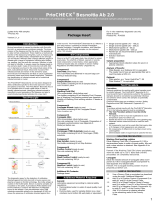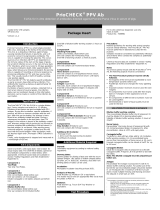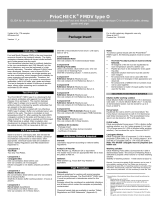Page is loading ...

PrioCON conjugates
Diagnostic procedures for Classical Swine fever
Detection and differentiation of pestiviruses in pigs
©Prionics AG
Version 1.1_e
For in-vitro veterinary diagnostic use only
Product numbers: 7610010, 7610015, 7610020,
7610025, 7610030, 7610035
Introduction
To diagnose classical swine fever (CSF) solely on
clinical symptoms and post mortem lesions is not
always possible. Significant differences exist between
symptoms caused by classical swine fever virus
(CSFV) strains of high, intermediate and low virulence.
Therefore, diagnosis of CSF must be made in the
laboratory where CSFV can be detected in tissue
specimens, isolated in an appropriate cell system, and
where sera can be tested for antibodies against CSFV.
The immuno-fluorescence test (IFT) is used to detect
CSF-antigen in cryostat sections of organ specimens.
This test is performed with a conjugate prepared from
a polyclonal anti-CSF serum, therefor it cannot differ-
entiate between pestiviruses. To differentiate pestiviru-
ses, monoclonal antibodies (MAbs) are used in an
immunoperoxidase test (IPT). Serology is performed
with the –PrioCHECK® CSFV Ab ELISA for the
detection of CSFV antibodies (Ab). The neutralization
peroxidase- linked assay (NPLA) can be used to
confirm the positive results obtained in the Pri-
oCHECK® CSFV Ab.
Described are the laboratory techniques and procedu-
res used to detect and differentiate pestiviruses, and to
detect and differentiate antibodies directed against
pestiviruses, according to the national Dutch reference
laboratory for Classical Swine Fever Virus (CIDC, the
Netherlands).
Test Principles
THE DIRECT IMMUNOFLUORESCENCE TEST (IFT)
USING THE PRIOCON FITC PAN-PESTIVIRUS
The IFT detects viral antigens. The test is performed
on cryostat tissue sections of the tonsil, spleen, kid-
ney, and the distal part of the ileum. Tissue sections
are incubated with a fluorescein labeled anti-pestivirus
globulin (conjugate). The sections are examined for
fluorescent cells with an ultraviolet light microscope.
Since the IFT employs a conjugate prepared from a
polyclonal anti-CSFV globulin it cannot differentiate
between antigens of various pestiviruses. Therefore, a
positive result with the IFT must be followed by an
immunoperoxidase test (IPT) using monoclonal anti-
bodies (MAbs) that can differentiate CSFV from other
pestiviruses.
THE IMMUNOPEROXIDASE TEST (IPT) USING
PRIOCON HRPO PAN-PESTIVIRUS, PRIOCON
HRPO 21.2, PRIOCON HRPO 44.3 AND PRIOCON
HRPO 63.19
To detect whether a positive result with the IFT is
caused by CSF field virus, CSF vaccine virus, bovine
viral diarrhoea virus (BVDV) or border disease virus
(BDV), differentiation with monoclonal antibodies
(MAbs) specific for CSF and the Chinese vaccine
strain of CSF is performed.
Cryostat sections of the tonsil are separately incubated
with 3 different peroxidase labeled MAbs (coded
PrioCON HRPO 21.2, PrioCON HRPO 44.3, Pri-
oCON HRPO 63.19 and a peroxidase labeled polyclo-
nal antibody PrioCON HRPO Pan-pestivirus.
It is recommended to incubate all conjugates on
positive reference sections as well. Subsequently all
sections are stained with chromogen/substrate (AEC,
see Annex).
PrioCON HRPO 21.2 recognizes all CSFV strains.
PrioCON HRPO 44.3 does not recognize CSF vaccine
virus. Both conjugates do not recognize BVDV and
BDV. If the reaction with PrioCON HRPO 21.2, and
PrioCON HRPO 44.3 is negative and the sections
incubated with the PrioCON HRPO Pan-pestivirus
are positive, the diagnosis is BVDV or BDV. PrioCON
HRPO 63.19 detects only the Chinese strain of CSFV
and is added to the test when the vaccine virus of
CSFV is suspected.
THE NEUTRALIZATION PEROXIDASE LINKED
ASSAY (NPLA) USING PRIOCON HRPO 39.5
The NPLA is a neutralization test for the detection of
antibodies against CSFV or BVDV and is performed in
microtiter plates. Sera are inactivated and two-fold
dilutions (in duplicate) are incubated with the appro-
priate virus strain. After incubation, CSFV or BVDV
susceptible cells are added to the serum-virus mixture.
The cells grow to confluency in the wells of a micro-
titer plate. Virus, which is not neutralized by antibod-
ies, will propagate in the cells. CSFV propagates in
PK-15 cells and BVDV in MDBK (or EBTr) cells. The
dilution of the virus for use in the NPLA is critical since
it determines the sensitivity of the test. Appropriate
references must be incorporated in the test to estab-
lish sensitivity and specificity. Very important is the
absence of BVD virus as well as BVDV antibodies in
the foetal bovine serum (FBS) that is used in the
growth medium for the cells. After fixation, the cells
are incubated with a direct HRPO conjugate (39.5) to
detect the virus. Subsequently, the chromogen-
substate is added. The test serum is negative for
CSFV-antibodies when the cytoplasm of the cells is
stained deeply red. The test can be read macroscopi-
cally or, in case of doubt, with an inverted microscope.
Storage conditions
The undiluted FITC conjugates should be stored at
–20oC upon arrival.
The undiluted HRPO conjugates should be stored at
4oC upon arrival.
Test Procedures
PROCEDURE OF THE DIRECT IMMUNOFLUORES-
CENCE TEST (IFT)
1.1 Cut sections (4 µm) of the organ specimens on a
cryostat microtome. The sections are caught on
a coverslip.
1.2 Include a CSFV positive- and negative section in
the test to verify conjugate activity and back-
ground staining.
1.3 Dry the sections 15 minutes at 37°C or fixate the
sections 10 minutes in acetone.
1.4 Rinse the sections once in phosphate buffered
saline (PBS).
1.5 Prepare working dilution of conjugate in PBS.
Place the cover slips in a humid chamber and
dispense the working dilution of the PrioCON
FITC Pan-pesti in PBS on the sections.
1.6 Incubate 30 minutes at 37°C in the humid cham-
ber.
1.7 Wash the sections 5x 2 minutes in PBS/0,05 %
Tween 80 at room temperature (20 – 25°C).
1.8 Drain the cover slips and mount them on an
object slide with Mounting Buffer (from Prionics
Lelystad B.V.) (0,5 M carbonate buffer (pH 9.5)
diluted 1:10 in 100 % glycerol).
1.9 Examine the sections for fluorescent cells
(cytoplasm) with an ultraviolet light microscope.
1.10 Interpretation of the test.
In case of a positive IFT cytoplasmatic fluorescence
can be seen in:
- The epithelial cells which outline the tonsillar crypts;
- Lymphoid cells in the peri-arterial-lymphocyte-sheath
(PALS) of the spleen;
- The epithelial cells of the ascending limb of the loop
of Henle in the kidney;
- The epithelial cells of the villi in the ileum;
- Other cells of epithelial origin.
A negative IFT does not exclude CSF. In case of a
suspicious clinical picture, tissue specimens from
additional pigs from the suspected farm must be
investigated. Simultaneously, virus isolation can be
attempted.
Annex IFT
To decrease non-specific background staining, speci-
mens can be counterstained, using Counterstain
(0,01% Evan’s Blue) from Prionics Lelystad B.V.
- Dilute Counterstain 50x in the working dilution of the
conjugate.
THE IMMUNOPEROXIDASE TEST (IPT) USING
PRIOCON HRPO PAN-PESTIVIRUS, PRIOCON
HRPO 21.2, PRIOCON HRPO 44.3 AND PRIOCON
HRPO 63.19
2.1 Cut eight more sections (4µm) of the IFT-positive
organ (usually the tonsil but kidney sections pro-
vide a good picture as well). Sections are caught
on a cover slip.
2.2 Dry de sections for 15 minutes at 37°C or fixate
the sections in acetone for 10 minutes.
2.3 Rinse the sections once in PBS/0,05 %
Tween80.
2.4 Prepare working dilution of conjugate in PBS (pH
7.6) + 0.05% Tween80 + 4% horse serum. Incu-
bate the sections (including CSFV positive- and
negative reference sections) with working dilu-
tion of PrioCON conjugates:
-2 sections with PrioCON HRPO 21.2
-2 sections with PrioCON HRPO 44.3
-2 sections with PrioCON HRPO 63.19 (if vac-
cine virus is suspected)
-2 sections with PrioCON HRPO Pan-
pestivirus.
2.5 Incubate for 1 hr at 37°C in the humid chamber.
2.6 Wash the sections 6x 10 seconds in PBS/0,05 %
Tween 80.
2.7 Rinse the sections once in 0,05 M sodium
acetate (pH 5,0).
2.8 Stain the sections with a freshly prepared chro-
mogen/substrate solution
(3-amino-9-ethyl-carbazole (AEC)) for 5 - 15
minutes at room temperature (20 – 25 °) (See
annex IPT).
2.9 Rinse the sections once in 0.05 M sodium
acetate (pH 5,0) and mount them on an object
slide.
2.10 Examine the sections with a light microscope.
A dark red stained cytoplasm of the epithelial
cells which outline the tonsillar crypts indicates
recognition of the virus by the respective conju-
gates, and is considered as a positive test result.
2.11 Interpretation of the test.
IFT
IPT Diagnosis
21.2
44.3
Pan-pesti
+
+
+
+
CSF
+
+
-
+
CSF vaccine
virus
*
?
+
-
-
+
BVDV/BDV
*Confirm virus specificity with MAb 63.19.
Package Insert

PrioCON conjugates
Annex IPT
Preparation of chromogen/substrate solution
(AEC)
Stock solution of chromogen:
1) 4 mg 3-amino-9-ethyl-carbazole (AEC)
2) 1 ml N,N-di-methyl-formamid
Prepare the following just before use:
3) 19 ml 0.05 M Na-acetate (pH 5.0)
4) Add per 20 ml AEC solution 10 ul 30 % H2O2
5) Filtrate the solution through a 5 micron acrodisc
filter (Gelman Sciences prod. no.4199).
Keep the AEC stock solution at 4°C in the dark.
PROCEDURE OF THE NPLA
Preparation of serum dilutions in microtiter plates
The starting dilution is 1:25 (OIE manual prescribes
1:10) and is made in a dummy plate. These dilutions
are transferred to the test plate in which the sera are
further diluted.
3.1 Dispense 240 µl growth medium
3.2 Dispense 10 µl of each test serum per well in the
growth medium (serum dilution is then 1:25) of
the dummy plate.
To test the sera in duplicate, dispense test se-
rum 1 in wells A1 and A2, serum 2 in wells A3
and A4 etc.
3.3 Shake the plates for 10 seconds on a microplate
shaker.
3.4 Transfer 100 µl of the 1:25 serum dilution in row
A of the dummy plate to the corresponding wells
of row A of the first test plate. Transfer 100 µl of
the 1:25 serum dilution in row B of the dummy
plate to the corresponding wells of row A of the
second test plate etc.
3.5 Dispense 50 µl of the growth medium in the rows
B through H of the test plate(s).
3.6 Make a two-fold dilution starting in row A of the
test plates by transferring 50 μl of row A to row
B, stir and transfer 50 µl to row C, etc.
3.7 Make a two-fold dilution of a strong positive con-
trol serum (in octuple) in the columns 1 through
6 of a separate (reference) plate.
3.8 Make a two-fold dilution of a weak positive
control serum in columns 7 through 11 of the
control plate (in octuple).
3.9 Dispense 100 µl of growth medium in column 12
of the reference plate. The wells in this column
serve as negative cell reference.
Incubation of serum dilutions with the (predetermi-
ned) virus working dilution
3.10 The working dilution must contain approximately
100 TCID50 per 50 µl of the virus (predetermined
by titration).
3.11 Add 50 µl of the virus working dilution to all wells
of the test plates containing the serum dilutions.
3.12 Dispense 50 µl growth medium in the wells of
columns 1 till 5 of the virus control plate.
3.13 Make a tenfold dilution (10-1 – 10-5) of the virus
working dilution in test tubes and dispense 50 µl
per dilution (in octuple) in the columns 1 till 5 of
the virus reference plate.
3.14 Incubate serum dilutions with virus working
dilution in the test plates and reference plates for
1 hr at 37°C in 5 % C02 incubator.
3.15 Add to the wells of all plates 50 µl growth medi-
um containing 2.105 cells per ml.
3.16 Incubate the cultures in a 5 % CO2 incubator at
37°C for 4 days (CSFV) or 5 days (BVDV). The
cells should grow gradually to confluency in 3
through 5 days.
Fixation and staining procedure
3.17 Discard the growth medium and rinse the plates
once in 0,15 M NaCl. Drain the plates thoroughly
by knocking them on a towel.
3.18 Fix the cells by heating the plates for 1 hr at
80°C.
3.19 Rinse the plates once in 0,15 M NaCl.
3.20 Prepare working dilution of PrioCON HRPO 39.5
in PBS + 0.05 % Tween 80 + 4 % horse serum.
Add to the wells of all plates 50 µl pre-diluted
conjugate. If a neutralization test for the detec-
tion of antibodies against BVDV is performed,
the MDBK cells can be stained with a prede-
termined dilution of a PO labeled CSFV- or
BVDV immune serum).
3.21 Incubate 1 hr (CSFV) or 2 hrs (BVDV) at 37°C.
3.22 Wash the plates 5x in PBS + 0,05 % Tween 80.
3.23 Add to all wells of the plates 50 µl of the chro-
mogen-substrate solution 3-amino-9-ethyl car-
bazole (AEC; See annex IPT).
3.24 Incubate the AEC on the cells for 15 - 30
minutes.
Reading and interpretation of the test
The test can be read macroscopically. In case of doubt
the monolayers should be examined with an inverted
microscope.
325 Deep red stained cytoplasm of the cells indicates
that the test serum is negative for antibodies.
Does the test serum contain antibodies, virus
growth is prevented by neutralization and the cy-
toplasm of the cells is not stained.
3.26 Calculate, via the titration of the virus working
dilution in the virus control plate, the number of
TCID50 according the method of Reed &
Muench. The number of TCID50 must be be-
tween 40 and 400.
3.27 Calculate the titers of the strong and weak positi-
ve control sera in the serum control plates accor-
ding to the method of Reed & Muench.
3.28 Determine the titer of the test sera. The titer of a
serum is expressed as the reciprocal of the
highest dilution that prevents virus growth in 50
% of the wells.
A serum with a titer in the CSFV-NPLA of
≥
25 is
considered positive.
A serum with a titer in the BVD-NPLA of
≥
5 is
considered positive.
Ordering information
- PrioCON FITC Pan-pestivirus
art# 7610035
- PrioCON HRPO Pan-pestivirus
art# 7610030
- PrioCON HRPO anti-CSFV (21.2)
art# 7610010
- PrioCON HRPO anti-CSFV (44.3)
art# 7610020
- PrioCON HRPO anti-CSFV C-strain (63.19)
art# 7610025
- PrioCON HRPO anti-CSFV (39.5)
art# 7610015
- Priotest Mounting Buffer
art# 7610037
- Priotest Counterstain (0.01% Evans Blue)
art# 7610036
Appendix I
Notice
This manual is believed to be complete and accurate
at the time of publication. In no event shall Prionics AG
be liable for incidental or consequential damage in
connection with or arising from the use of this manual.
Liability
Prionics AG warrants its products will meet their
applicable published specification when used in
accordance with their applicable instructions and
within the declared products life time. Prionics AG
makes no other warranty, expressed or implied. There
is no warranty of merchantability or fitness for a partic-
ular purpose. The warranty provided herein and the
data, specifications and descriptions of Prionics AG
products appearing in Prionics AG published cata-
logues and product literature may not be altered
except by express written agreement signed by an
officer of Prionics AG. Representation, oral or written,
which are inconsistent with this warranty or such
publications are not authorized and if given, should not
be relied upon.
In the event of a breach of the foregoing warranty,
Prionics AG’s sole obligation shall be to repair or
replace, at its option, the applicable product or part
thereof, provided the customer notifies Prionics AG
promptly of any such breach. If after exercising rea-
sonable efforts, Prionics AG is unable to repair or
replace the product or part, then Prionics AG shall
refund to the customer all monies paid for such appli-
cable product or part.
Prionics AG shall not be liable for consequential,
incidental, special or any other indirect damages
resulting from economic loss or property damage
sustained by any customer from the use of its prod-
ucts.
Prionics AG and Prionics Lelystad B.V. are ISO
9001:2000 certified companies.
Appendix II
References
1. Terpstra, C. and Wensvoort, G. (1988a) Natural
infections of bovine viral diarrhoea virus in pigs,
associated with signs resembling swine fever.
Res. Vet. Sci., 45: 137-142.
2. Wensvoort, G. and Terpstra, C. (1988) Bovine
viral diarrhoea infections in piglets born from
sows vaccinated against swine fever with con-
taminated vaccine. Res. Vet. Sci., 45: 143 - 148.
3. Terpstra, C. (1978). Detection of C-strain virus in
pigs following vaccination against swine fever.
Tijdschr. Diergen. 103, 678 - 684.
4. Wensvoort, G., Terpstra, C., Boonstra, J.,
Bloemraad, M. and van Zaane, D. (1988). Pro-
duction of monoclonal antibodies against swine
fever virus and their use in laboratory diagnosis.
Vet. Microbiol. 12, 101 - 108.
5. Wensvoort, G., Bloemraad, M. and Terpstra, C.
(1988) An enzyme-immunoassay, employing
monoclonal antibodies and detecting specifically
antibodies against classical swine fever virus.
Vet. Microbiol. 17, 129 - 140.
6. Terpstra, C., Bloemraad, M. and Gielkens, A.L.J.
(1984). The neutralizing peroxidase-linked assay
for detection of antibody against swine fever vi-
rus. Vet. Microbiol. 9, 113 - 120.
7. Wensvoort, G., Terpstra, C., de Kluijver, E.P.,
Kragten, C., and Warnaar, J.C. (1989) Antigenic
differentiation of pestivirus strains with mono-
clonal antibodies against hog cholera virus. Vet.
Microbiol., 21: 9 - 21.
Contact
Prionics Lelystad B.V.
Platinastraat 33
P.O. Box 2271
NL-8203 AG Lelystad
The Netherlands
Tel. +31 320 714000
Fax +31 320 714029
Prionics AG
Wagistrasse 27a
CH-8952 Schlieren-Zurich
Switzerland
Tel. +41 44 200 2000
Fax +41 44 200 2010
www.prionics.com
info@prionics.com
For our distribution network, please refer to
www.prionics.com
/









